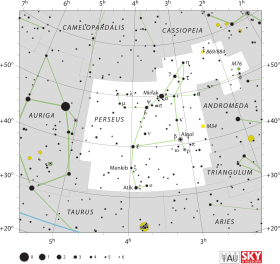
V1500 Cygni or Nova Cygni 1975 was a bright nova occurring in 1975 in the constellation Cygnus. It had the second highest intrinsic brightness of any nova of the 20th century, exceeded only by CP Puppis in 1942.

T Coronae Borealis, is a recurring nova in the constellation Corona Borealis. It was first discovered in outburst in 1866 by John Birmingham, although it had been observed earlier as a 10th magnitude star.

V1668 Cygni was a nova that appeared in the northern constellation of Cygnus, situated a couple of degrees to the southeast of the star Rho Cygni. It was discovered by Canadian variable star observer Warren Morrison on September 10, 1978, and reached a peak brightness of around 6.22 apparent magnitude on September 12. The luminosity of the source at this time was about 100,000 times the brightness of the Sun, and likely remained at that level for several months. The expansion velocity of the nova shell was deduced through spectroscopy to be 1,300 km/s.
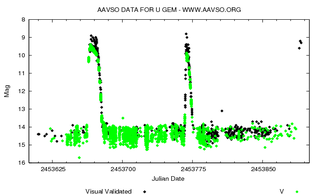
U Geminorum, in the constellation Gemini, is an archetypal example of a dwarf nova. The binary star system consists of a white dwarf closely orbiting a red dwarf. Every few months it undergoes an outburst that greatly increases its brightness. The dwarf nova class of variable stars are often referred to as U Geminorum variables after this star.
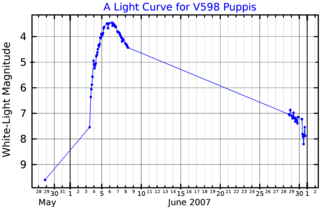
V598 Puppis is the name given to a nova in the Milky Way Galaxy. USNO-A2.0 0450-03360039, a catalog number for the star, was discovered to be much brighter than normal in X-ray emissions on October 9, 2007, by the European Space Agency's XMM-Newton telescope. The star was confirmed to be over 10 magnitudes, or 10,000 times, brighter than normal by the Magellan-Clay telescope Magellan-Clay telescope at Las Campanas Observatory in Chile. Pre-discovery images and identification of the progenitor would ultimately shows that the nova brightened from visual magnitude 16.6 to brighter than magnitude 4.
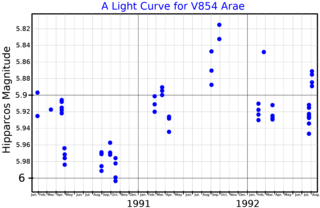
HD 155035 is the Henry Draper Catalogue designation for a star in the constellation Ara, the Altar. It is located at a distance of approximately 1,450 light-years from Earth and has an apparent visual magnitude of 5.92, making it is faintly visible to the naked eye. This is a red giant star with a stellar classification of M1.5 III. It an irregular variable that changes brightness over an amplitude range of 0.12 magnitudes.
HD 36678 is single star in the northern constellation of Auriga. This star is dimly visible to the naked eye with an apparent visual magnitude of 5.83. It is located at a distance of approximately 840 light years from the Sun based on parallax.

SS Cygni is a variable star in the northern constellation Cygnus. It is the prototype of the subclass of dwarf novae that show only normal eruptions. It typically rises from 12th magnitude to 8th magnitude for 1–2 days every 7 or 8 weeks. The northerly declination of SS Cygni makes the star almost circumpolar from European and North American latitudes, allowing a large proportion of the world's amateur astronomers to monitor its behavior. Furthermore, since the star lies against the rich backdrop of the Milky Way band, the telescope field of view around SS Cygni contains an abundance of useful brightness comparison stars.

NSV 1436 is a cataclysmic variable star in the constellation Perseus. It is a probable U Geminorum-type dwarf nova, and outbursts have been observed in 1948 and 2011. It is also listed in the General Catalogue of Variable Stars as V1024 Persei.

X Persei is a high-mass X-ray binary system located in the constellation Perseus, approximately 950 parsecs away. It is catalogued as 4U 0352+309 in the final Uhuru catalog of X-ray objects.
98 Herculis is a single star located approximately 590 light years from the Sun in the northern constellation Hercules. It is visible to the naked eye as a dim, red-hued point of light with an apparent visual magnitude of 4.96. The brightness of the star is diminished by an extinction of 0.19 due to interstellar dust. The star is moving closer to the Earth with a heliocentric radial velocity of −19 km/s.

1 Persei is an eclipsing binary star in the constellation Perseus. Its uneclipsed apparent magnitude is 5.49. The binary star consists of two B2 type main-sequence stars in a 25.9 day eccentric orbit. The stars are surrounded by a faint cloud of gas visible in mid-infrared, although whether they are the origin of the gas or simply passing through it is unclear.

KT Eridani was a bright nova in the constellation Eridanus that produced an outburst in 2009. It was the first classical nova ever detected in that constellation. The nova was discovered at 12:52 UT on 25 November 2009 by K. Itagaki at Yamagata, Japan with a 21 cm patrol telescope. At the time of its discovery, it was a magnitude 8.1 object. The discovery occurred after the nova's peak brightness, but the All Sky Automated Survey system had detected the nova on three earlier occasions, allowing a more complete light curve to be produced. The peak magnitude, 5.4, was seen at 15:10 UT on 14 November 2009.

RR Telescopii is a symbiotic nova in the southern constellation Telescopium. It was recorded on photographic survey plates as a faint variable star between photographic magnitude (mpg) 9 to 16.6 from 1889 to 1944. In late 1944 the star began to brighten, increasing by about 7 magnitudes, from mpg ≈ 14 to brighter than 8. Brightening continued with a diminished rate of increase after early 1945, but the overall outburst was not noted until the star was seen at about 6.0, the threshold of naked eye brightness, in July 1948. At that time it was given the designation Nova Telescopii 1948. Since mid-1949 it has declined in brightness slowly, albeit accompanied by some remarkable changes in its spectrum, and as of August 2013 it had faded to visual magnitude around 12.

9 Persei is a single variable star in the northern constellation Perseus, located around 4,300 light years away from the Sun. It has the Bayer designation i Persei; 9 Persei is the Flamsteed designation. This body is visible to the naked eye as a faint, white-hued star with an apparent visual magnitude of about 5.2. It is moving closer to the Sun with a heliocentric radial velocity of −15.2 km/s. The star is a member of the Perseus OB1 association of co-moving stars.

V Antliae is a Mira variable star in the constellation Antlia. It varies in brightness between magnitudes 8.2 and 14.0 with a period of 303 days.
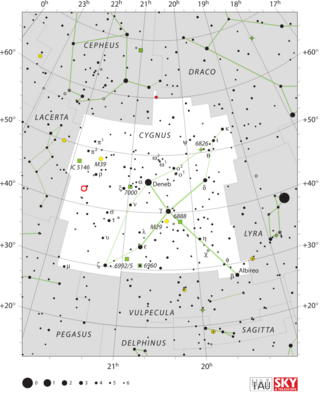
Q Cygni, is a star located in the constellation Cygnus. It is also known as Nova Cygni 1876, and has the designation NGC 7114, and HR 8296. Nova Cygni is located in the northwestern portion of Cygnus along the border with Lacerta.

BV Centauri is a cataclysmic variable binary star in the constellation Centaurus. It is a dwarf nova, and undergoes rapid increases in brightness that are recurrent with a mean period of 150 days. This period seems to have increased in the last few decades. During quiescence, its visual apparent magnitude is about 13, with variations of a few tenths of magnitude over an orbit due to differences in the star's visible surface area, brightening to a maximum magnitude of 10.7 during outbursts. From its luminosity, it is estimated that the system is about 500 parsecs (1,600 ly) away from Earth. A Gaia parallax of 2.81 mas has been measured, corresponding to about 360 pc.

SU Ursae Majoris, or SU UMa, is a close binary star in the northern circumpolar constellation of Ursa Major. It is a periodic cataclysmic variable that varies in magnitude from a peak of 10.8 down to a base of 14.96. The distance to this system, as determined from its annual parallax shift of 4.53 mas, is 719 light-years. It is moving further from the Earth with a heliocentric radial velocity of +27 km/s.

V841 Ophiuchi was a bright nova discovered by John Russell Hind on 27 April 1848. It was the first object of its type discovered since 1670. At the time of its discovery, it had an apparent magnitude of 5.6, but may have reached magnitude 2 at its peak, making it easily visible to the naked eye. Near peak brightness it was described as "bright red" or "scarlet", probably due to Hα line emission. Its brightness is currently varying slowly around magnitude 13.5. The area of the sky surrounding this nova had been examined frequently by astronomers prior to the nova's discovery, because it was near the reported location of "52 Serpentis", a star John Flamsteed had included in his catalogue with erroneous coordinates.
